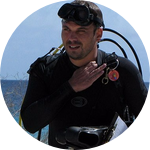About This Project
The incredible diversity of colors displayed by coral reef fishes is one the most striking yet poorly understood aspects of their biology. We will measure both fish color and environmental light attenuation to develop an understanding of how color evolves in reef fishes. This conceptual framework will allow us to forecast how contemporary changes to reef habitats, especially those in water clarity, will impact coral reef ecosystems and conservation initiatives in the near future.
Ask the Scientists
Join The DiscussionWhat is the context of this research?
The huge diversity of color displayed by coral reef fishes is one the most striking yet poorly understood aspects of their biology. While some projects have provided insight into the role of color in sexual selection, they focused in on one group or species. We still lack a fundamental understanding of fish color evolution, and we need the big picture if we are serious about conserving colorful reef systems in the face of emerging problems across the world's oceans.
Our observations suggest that there is a relationship between water clarity and the abundance of colorful fish. However, this link has never been tested. This project will be the first to quantify color across a community of reef fish and to examine if color diversity declines with disturbance.
What is the significance of this project?
Understanding the relationship between reef ecosystem health and the presence of color is of both high conservation and economic importance. Colorful reef fish are a critical part of marine food webs, and a major component of underwater ecotourism and the marine aquaculture industry. Examining color diversity in a community of fish in the context of reef health will provide a framework with which can predict how local and global changes in coral health can fragment populations of colorful fish.
If coral habitats continue to be altered on a global scale, colorful reef fish could be at risk.
What are the goals of the project?
To understand the color diversity of coral reef fish, we will deploy underwater radiometers that measure how light penetrates water, and how it is absorbed or scattered throughout the day. These units will be deployed for several days at each site, allowing us to quantify the light profile of each habitat (e.g., how turbid is it?).
While the sensors record habitat data, we will catch fish underwater and return them to the CARMABI research station to measure color using a hyperspectral camera. We will also catch fish underwater and place them into a custom acrylic housing that we can use to create calibrated images of the fishes at depth, allowing us cross-validate the color composition of fish at a site and test how fish color changes at different levels of habitat disturbance.
Budget
The funds requested here are critical to the success of the larger project. Our proposed budget will primarily cover the cost of airfare for four scientific divers to Curaçao, and the remainder will pay for laboratory fees at the CARMABI research station and rented field gear, including SCUBA air re-fills.
Curaçao is an ideal location for collecting data. Near-shore reefs enable our team to easily access multiple field sites and the on-site nature of this project enables the team to take direct, accurate color measurements on both healthy and disturbed reefs (sites impacted by shipping channel traffic and urban activity).
Our proposed research on reef degradation and reef fish color is the first of its kind. Our findings will provide the scientific community with data crucial to evolutionary theory, conservation and environmental policies.
Endorsed by
Meet the Team
Affiliates
Affiliates
Alex Dornburg
As the curator of ichthyology at the North Carolina Museum of Natural Sciences, my research takes an integrative approach to explore the factors that underlie the origin and maintenance of biodiversity in ray-finned fishes (Actinopterygii).
I have always been captivated by the diversity of fishes. I had a small fish tank as a kid, and would demand trips to the aquarium. I then learned how to fish and eventually scuba dive as I got older. As I began turning a fascination with fish into a career, I could not help but be amazed by how many different types of fish share the planet with us today.
Fish have successfully colonized virtually any part of the world that contains water, making a living in ecosystems ranging from coral reefs to the Southern Ocean of Antarctica. Ray-finned fish have done this so well that they collectively no make up over half of all living vertebrates.
I want to understand the evolutionary pathways that made fishes so successful and use that knowledge to predict what keeps this diversity around. Doing so facilitates a broader understanding of not only how biological diversity has accumulated but also illuminates the utility of evolutionary biology in conservation.
For more info see: carolinafishes.github.io
Michael Alfaro
The central goal of my research program is to understand the factors that govern the evolutionary dynamics of organismal diversification. Why are some groups morphologically diverse? Are there general laws or themes that can be used to explain the uneven distribution of diversity in physiological traits across lineages? Does morphological diversity always signal mechanical, functional, or ecological diversity? To address these questions, I work largely on marine fishes. My research approach is interdisciplinary and quantitative and crosses traditional boundaries among evolutionary morphology, molecular phylogenetics, and theoretical evolution. I identify and quantify organismal diversity using morphological and functional morphological techniques; construct evolutionary trees and test evolutionary hypotheses using phylogenetic statistical methods; and use models of trait evolution to explore form-function dynamics.
For more info see: UCLA Department of Ecology and Evolutionary Biology
Sarah Federman
I am a PhD candidate in Yale University’s department of Ecology & Evolutionary Biology, with a broad interest in the evolution and maintenance of tropical biodiversity. My research focuses on the development of wet-forest biomes in Madagascar, and floristic diversity, specifically that of Canarium (Burseraceae). I am particularly interested in the ways in which extinctions can structure systems, and how this knowledge can inform policy, conservation, and management. I have previously worked in marine biology research in collaboration with Alex, and am excited to continue pursuing my interest in the evolution and conservation of tropical biodiversity in the context of color and coral reefs.
Katerina Zapfe
I am a born naturalist with a Bachelors in Marine Science from NC State University. My love for the natural world began early as a child snorkeling off Grand Cayman. A busy, vibrant, water-based world below the waves was both mysterious and fascinating. I went on to become involved with study abroad research in the Bahamas, animal husbandry through The Maritime Aquarium and marine biology education with the Sea Turtle Camp. These experiences expanded my passion for marine science. Since working at the NCMNS, I have become interested in how understanding evolutionary pathways can inform conservation biology. I aspire to attend graduate school next year and inspire others to develop their own passion for marine life.
Additional Information
This project is the first step towards developing a theory-based understanding of color evolution in reef fishes, and is a collaborative effort among several research institutions. As a first step, we want to know whether the a decline in the health of coral reefs is linked to the loss of colorful reef fish.
Our data will also provide a foundation for:
1) Understanding of how fish perceive color at depth, a collaboration with researchers at Princeton University
2) Developing software that will make student and public participation in this conservation issue possible (see additional info), a collaboration with researchers at UCLA and Yale University
We have already built the framework of an interactive program, 1Fish2Fish, that allows users to measure color on a photograph. By adding photographs of fish living in healthy and unhealthy habitats around Curacao, we can directly bring our experiences to students. This will create an engaging distance learning tool that brings hands-on conservation work into high-school classrooms. We plan to integrating our work with existing distance learning programs at our institutions. By doing so, reef fish color loss is no longer an abstract concept but something that students can directly observe.
Project Backers
- 16Backers
- 24%Funded
- $949Total Donations
- $55.82Average Donation






